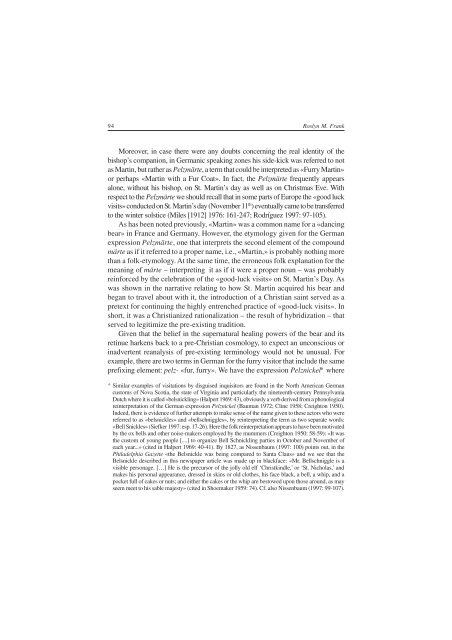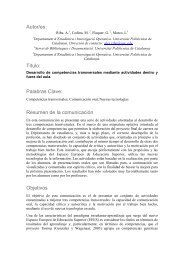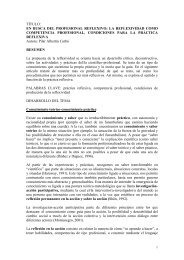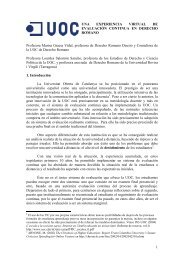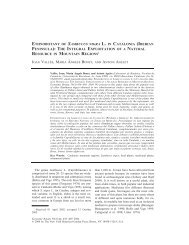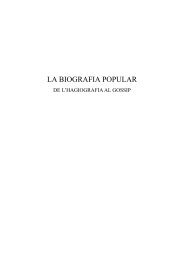Impaginato 5.p65 - Universitat Rovira i Virgili
Impaginato 5.p65 - Universitat Rovira i Virgili
Impaginato 5.p65 - Universitat Rovira i Virgili
Create successful ePaper yourself
Turn your PDF publications into a flip-book with our unique Google optimized e-Paper software.
94<br />
Roslyn M. Frank<br />
Moreover, in case there were any doubts concerning the real identity of the<br />
bishop’s companion, in Germanic speaking zones his side-kick was referred to not<br />
as Martin, but rather as Pelzmärte, a term that could be interpreted as «Furry Martin»<br />
or perhaps «Martin with a Fur Coat». In fact, the Pelzmärte frequently appears<br />
alone, without his bishop, on St. Martin’s day as well as on Christmas Eve. With<br />
respect to the Pelzmärte we should recall that in some parts of Europe the «good luck<br />
visits» conducted on St. Martin’s day (November 11 th ) eventually came to be transferred<br />
to the winter solstice (Miles [1912] 1976: 161-247; Rodríguez 1997: 97-105).<br />
As has been noted previously, «Martin» was a common name for a «dancing<br />
bear» in France and Germany. However, the etymology given for the German<br />
expression Pelzmärte, one that interprets the second element of the compound<br />
märte as if it referred to a proper name, i.e., «Martin,» is probably nothing more<br />
than a folk-etymology. At the same time, the erroneous folk explanation for the<br />
meaning of märte – interpreting it as if it were a proper noun – was probably<br />
reinforced by the celebration of the «good-luck visits» on St. Martin’s Day. As<br />
was shown in the narrative relating to how St. Martin acquired his bear and<br />
began to travel about with it, the introduction of a Christian saint served as a<br />
pretext for continuing the highly entrenched practice of «good-luck visits». In<br />
short, it was a Christianized rationalization – the result of hybridization – that<br />
served to legitimize the pre-existing tradition.<br />
Given that the belief in the supernatural healing powers of the bear and its<br />
retinue harkens back to a pre-Christian cosmology, to expect an unconscious or<br />
inadvertent reanalysis of pre-existing terminology would not be unusual. For<br />
example, there are two terms in German for the furry visitor that include the same<br />
prefixing element: pelz- «fur, furry». We have the expression Pelznickel 6 where<br />
6 Similar examples of visitations by disguised inquisitors are found in the North American German<br />
customs of Nova Scotia, the state of Virginia and particularly the nineteenth-century Pennsylvania<br />
Dutch where it is called «belsnickling» (Halpert 1969: 43), obviously a verb derived from a phonological<br />
reinterpretation of the German expression Pelznickel (Bauman 1972; Cline 1958; Creighton 1950).<br />
Indeed, there is evidence of further attempts to make sense of the name given to these actors who were<br />
referred to as «belsnickles» and «bellschniggles», by reinterpreting the term as two separate words:<br />
«Bell Snickles» (Siefker 1997: esp. 17-26). Here the folk reinterpretation appears to have been motivated<br />
by the ox bells and other noise-makers employed by the mummers (Creighton 1950: 58-59): «It was<br />
the custom of young people [....] to organize Bell Schnickling parties in October and November of<br />
each year...» (cited in Halpert 1969: 40-41). By 1827, as Nissenbaum (1997: 100) points out, in the<br />
Philadelphia Gazette «the Belsnickle was being compared to Santa Claus» and we see that the<br />
Belsnickle described in this newspaper article was made up in blackface: «Mr. Bellschniggle is a<br />
visible personage. […] He is the precursor of the jolly old elf ‘Christkindle,’ or ‘St. Nicholas,’ and<br />
makes his personal appearance, dressed in skins or old clothes, his face black, a bell, a whip, and a<br />
pocket full of cakes or nuts; and either the cakes or the whip are bestowed upon those around, as may<br />
seem meet to his sable majesty» (cited in Shoemaker 1959: 74). Cf. also Nissenbaum (1997: 99-107).


